Home » Gemstones » American Gemstones » Idaho
Idaho Gemstone Mining
Garnet and opal are Idaho's most important gems, but many others have been produced in the state.
Author: Hobart M. King, PhD, GIA Graduate Gemologist
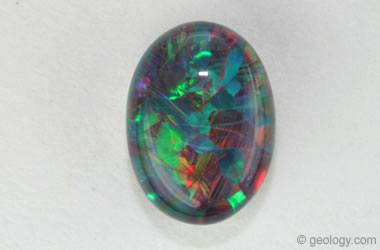
Idaho Harlequin Opal: Photo of a harlequin opal triplet from the Constellation Mine near Spencer, Idaho. It is 6 millimeters by 4 millimeters in size.
A Diversity of Gems from Idaho
Idaho's nickname is "The Gem State." It has a long history of producing a variety of gem materials. The most important gems produced to date have been garnet and opal. Notable amounts of jade, topaz, zircon, and tourmaline have also been found in Idaho. Agate, jasper, and petrified wood in many colors and patterns have been found and produced from small deposits in many parts of the state.
Table of Contents
 Idaho Garnet Idaho Garnet Garnet Abrasives Garnet Abrasives Gem-Quality Garnet Gem-Quality Garnet Idaho Opal Idaho Opal Idaho Jasper Idaho Jasper Petrified Wood Petrified Wood Rockhounding in Idaho Rockhounding in Idaho Going to Jail for Collecting Rocks? Going to Jail for Collecting Rocks? |
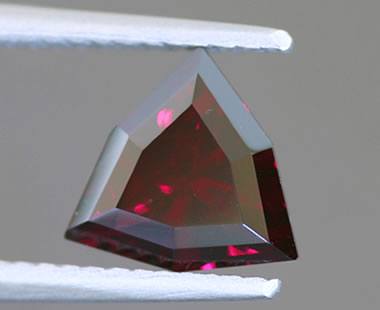
Idaho Rhodolite Garnet: This is a photo of a dark purplish red rhodolite garnet from Crystal Creek, Idaho. The stone measures about 9 millimeters across and weighs 2.95 carats. Photo by Bradley Payne of TheGemTrader.com.
Idaho Garnet
Garnet in Idaho is found in pegmatites, garnetiferous schists, mica schists, and other metamorphic rocks. It can be removed from these rocks or found in the soils that have formed above them. However, most of the garnets that have been produced in Idaho have been from the sands and gravels of placer deposits. This is where they can be most easily produced.
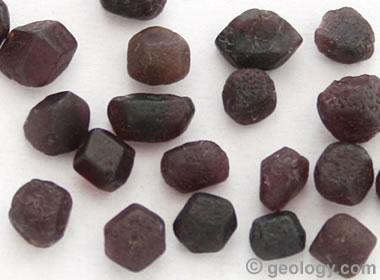
Idaho garnet: These almandite-spessartite garnets are from an alluvial deposit in Idaho. They have been transported a short distance from their source rock, and some still retain evidence of their dodecahedral crystal form. They are about four to five millimeters in size and weigh about 0.6 to 0.8 carats each.
Garnet Abrasives
People have been searching the stream gravels of Idaho for garnets since the late 1800s, but commercial production did not begin until the early 1940s. At that time, thin gravel layers in the sediments along Emerald Creek, Carpenter Creek, and Meadow Creek in the Idaho panhandle were being mined for garnet abrasive.
The gravel layers containing the garnet were only a few feet thick, but they consisted of up to 15% almandite garnet by weight. The garnets ranged from sand-sized up to over two inches in diameter. They were being weathered from mica-garnet schist in the upper part of the drainage basins.
|
Most of the garnets in these sediments were not gem quality. They were mined and crushed to produce garnet abrasive granules. At some operations, gem-quality stones were picked out by hand before crushing. The deposits were worked from the 1940s through the 1980s and were an important source of industrial garnet in the United States at that time. Today, most abrasive granules used in industry are manufactured materials rather than natural materials. It is unlikely that garnet mining for abrasive use will return to Idaho in the future.
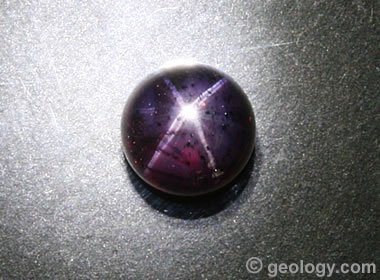
Idaho Star Garnet: This is a photo of a four-ray star garnet from northern Idaho. It is a deep purple almandite that is almost black without strong illumination. This stone measures about six millimeters across and about four millimeters high and weighs about 1.5 carats. It is heavily included in addition to the silk that produced the star.
Gem-Quality Garnet
Gem-quality garnets have been found in the sediments of many Idaho streams. They are mostly deep red almandite and purplish red almandite-spessartite.
The most interesting surprise was the discovery of star garnets. These purplish red almandite garnets contain fine rutile needles that produce four-ray stars or six-ray stars when the rough is properly oriented and cut into cabochons. Cutting the garnets to properly produce a star is not easy, and only highly skilled cutters are able to consistently produce them with a nicely centered star.
Star garnets are extremely rare. India and Idaho are the two most famous star garnet localities and the only places where they have been produced in commercial quantities. Small amounts of star garnets have also been found in Russia, Brazil, and North Carolina.
It is highly unlikely that you will ever find a star garnet for sale in a mall jewelry store. Because of their rarity, they are almost never placed in commercial jewelry and most jewelry buyers do not know they exist. Most of the star garnets found go into gem collections, mineral collections, and custom jewelry.
Idaho is the most likely place for you to find a star garnet being offered for sale in jewelry. In 1967, the Idaho Legislature designated star garnet as the official state gemstone. This has given the gem a some local popularity and they can occasionally be found for sale at a lapidary show or a specialty jewelry stores.
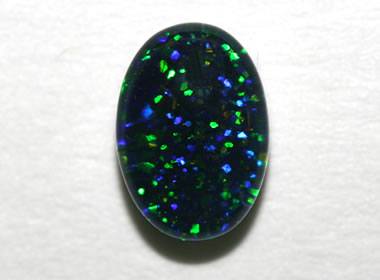
Pinfire opal: Photo of an opal triplet with a pinfire pattern from the Constellation Mine in Spencer, Idaho. It is 6 millimeters by 4 millimeters in size.
Idaho Opal
Opal has been found at many locations in Idaho, and mines there have produced it since the early 1900s. Most of the production has been from small mining operations and open cuts worked by two or three people. There have also been a few "fee mining" locations where individuals can pay a fee, search for opal, and keep any that they find.
Today, commercial opal production in Idaho occurs at a few locations near the town of Spencer. The largest producer is Spencer Opal Mines. They mine precious opal and sell rough and cut stones. They also have an area where visitors can search through material trucked in from their mine and keep any opals that they find.
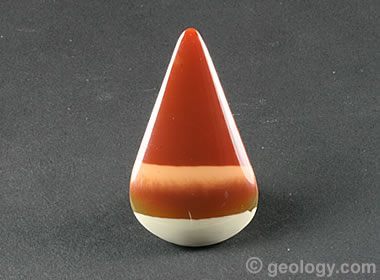
Bruneau Jasper: A cabochon cut from Bruneau Jasper from Owyhee County, Idaho.
Idaho Jasper
Jasper has been found in many locations in Idaho. Some of them have become popular enough to be widely known. These include Owyhee, Willow Creek, Graveyard Point Plume, and Prudent Man Jaspers.
The most famous jasper from Idaho is Bruneau Jasper, mined in Bruneau Canyon in Owyhee County. Its typical color range is from brown to brownish cream and red to reddish cream, marked with sweeping curves and ovals. The jasper precipitated within the gas cavities, fractures, and breccia voids of several rhyolite flows. It is very colorful and nicely patterned. It is not unusual to see slabs the size of a person's hand sell for $100 or more.
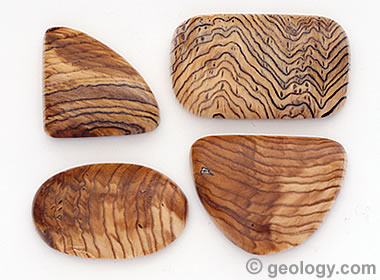
Herringbone Sequoia: These cabochons were cut from an opalized wood known as Herringbone Sequoia. The rough was found in the Snake River / Hell's Canyon area by an old-time rockhound in the mid-1900s and was sold as part of his estate. It is uncertain if it was found on the Idaho or Oregon side of the canyon. Whichever state it came from, it is a beautiful and unique material. It is definitely opalized wood (specific gravity = 2.106, spot refractive index = 1.48). These cabochons were cut by Greta Schneider of Copper Creek Cabs.
Petrified Wood
Petrified wood is found at many locations in Idaho. The Idaho Department of Lands reports silicified wood occurrences in Custer, Gem, Lincoln, Owyhee, and Washington Counties, with occurrences of opalized wood in Boundary, Gem, Gooding, Latah, and Owyhee Counties. You can view their gemstone guides here and here.
The Virtual Petrified Wood Museum has an article with nice photos describing Bruneau Woodpile, a location where collecting is possible. Bruneau Woodpile is a unique deposit because the wood is mineralized by apatite! The deposit is of Miocene/Pliocene age and contains a diversity of wood species, including both hardwoods and conifers. The article includes directions to the deposit and collecting suggestions.
Hunt For Gems - Keep What You Find!There are over 100 mines in the United States where anyone can visit, pay a small fee, look for gems and minerals, and keep what they find. For a large list of these mines, visit our Fee Mining Page on RockTumbler.com. |
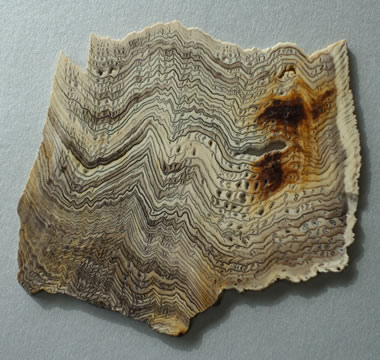
Herringbone Sequoia: A slab of Herringbone Sequoia. This material has an interesting zigzag pattern and "pecky pocket rot holes" that are often lined with mineral material. Click here to get a more detailed view of some Herringbone Sequoia slabs. Photos by Greta Schneider of Copper Creek Cabs.
Rockhounding in Idaho
There are many locations in Idaho where you can look for rocks, minerals, fossils and gems. The most popular is searching on Bureau of Land Management (BLM) areas. Although BLM does not have any specially designated rockhounding areas in the state, you can obtain maps showing areas where collecting can be done at one of their twelve field offices in the state. They also publish rules for collecting on BLM lands in their Rockhounding in Idaho (a .pdf download) pamphlet.
Numerous gem, rockhounding and general geology guides have been published for Idaho. Some of the more popular are:
- Gem Trails of Idaho and Western Montana by Lanny Ream
- Idaho Gold and Gems Map by R.N./M.L. Preston
- Northwest Treasure Hunter's Gem and Mineral Guide by Kathy J. Rygle and Stephen F. Pedersen
- Rockhounding Idaho by Garret Romaine
- Roadside Geology of Idaho by David Alt and Donald W. Hyndman
- Geology Underfoot in Southern Idaho by Shawn Willsey
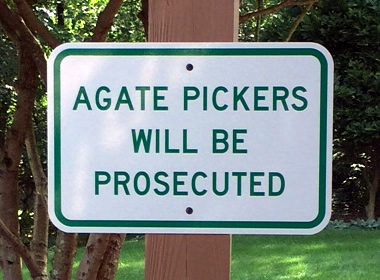
Signs like this on private property indicate that the property owner does NOT want people collecting agates on their land. There may be various reasons for this: They want to avoid potential liability; they simply don't want people on their land; they want the agates for their own personal use; the agates are valuable; or they have a reason that is none of your business. For a lot more information about this, please see our article Legal Aspects of Rock, Mineral, and Fossil Collecting by Timothy J. Witt, J.D.
Going to Jail for Collecting Rocks?
Finally, before you go out to collect rocks, minerals, fossils, gems or any other material, you need to know the rules for collecting on private and public land. For collecting in Bureau of Land Management property, you should get in touch with the BLM field office as explained above. For collecting on private property, you will need permission from the landowner. For collecting in other areas, you will need permission from the person or organization in charge of the land.
Taking a few common rocks from private property without landowner permission is a crime known as "larceny" and you can get in trouble for it. Taking a lot of rocks from their property or a few very valuable rocks can be a crime known as "grand larceny" and you can go to jail for it. Remove the wrong type of fossil or cultural artifact from government land, and you can go to jail for a long time. Many people have learned this the hard way. For more information please see our article Legal Aspects of Rock, Mineral, and Fossil Collecting by Timothy J. Witt, J.D.
| More Gemstones |
 |
Tourmaline |
 |
Fancy Sapphires |
 |
Diamond |
 |
Canadian Diamond Mines |
 |
Birthstones |
 |
Pictures of Opal |
 |
Fire Agate |
 |
Blue Gemstones |

Find Other Topics on Geology.com:

|

| ||

|

| ||

|

| ||

|

|
